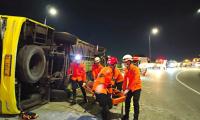LAHORE: A recent surge in the capital market is indicative of buoyancy in economy; however, this cheerfulness is not reflected in the quality of life of the society at large and it may be because the average rate of return of companies is far higher than the GDP growth rate.
Economists say that inequality of wealth increases if the rate of return on capital exceeds the economic growth of the country. The total income in a society is shared between the owners of the capital and the labour or employees. It is natural that owner of capital earns more than the cumulative earning of the employees. If a company is grows by ten percent and raises the payments of the employees by income even by ten percent the increase in wealth of owner would be staggeringly higher. On every Rs100 earned, the owner simply ends up increasing his wealth by Rs90. There is need to rethink the way the employees are rewarded.
Businessmen point out employees earns their salaries without any risk. They get their monthly payments even if the enterprise incurs loss. The owners earn better more in case of profits that covers his risks.
They have a valid point but this would never resolve the issue of increasing inequality. There is a dire need to find out a way that shields the businessmen in times of distress and reward the labour when the going is good. If at the end of a year a company earns 10 percent, it should award bonuses equivalent to 20 percent of their salary. This formula should be applied on percentage of earning of the company every year.
The businesses reinvest their earning in their projects. In such instances the net income reduces. Under an agreement, the labour should be given same bonus as on original profits. For their part, the employees should not expect any yearly raise or bonus if the company suffers loses. This would stop the inequality from widening further. According to International Monetary Fund (IMF), wage shares in nominal income are declining almost in all developed and developing economies.
The real problem with this is that the real wages grow less than real output. This results in the diminishing of the share of labour. When this process goes on for decades, it creates unrest in the society. The haves want status quo as it suits them, while have-nots are exploited by politicians with promises of reversing the trend. It has started happening in the advanced economies. Donald Trump in the US, Emmanuel Macron in France, and Angela Merkel in Germany are the outcome of disenchantment of the electorates from the parties of status quo. This trend is likely to move south if the solutions to inequalities are not found.
This continuously yawning gap between growth and productivity means lesser or no additional reward for the workers. The heartburn exacerbates when the workers find the owners of capital going up and up. Measuring equality is becoming difficult for the statisticians because of technological advances and globalisation. It is difficult to separate the income of the self-employed as it is difficult to divide it between labour and capital.
Another reason for inequality is that the cost of capital equipment has reduced due to technology. This has empowered businesses to be more productive at lower cost. Now smaller investments generate higher profit because of efficient technology. This increases disparity between capital and the labourer. In advanced economies many jobs have been replaced by robots or outsourced to low wage economies. Automation is also creeping into Pakistan as well. Though, the industrialisation has slowed down but whatever investment is coming in is producing more with lesser labour. At the same time obsolete industries are closing down shedding numerous jobs. The capitalists get away by handing over their projects to the banks, while parking the accumulated money elsewhere. Their wealth continues to grow in new avenues, while increasing joblessness multiplies inequality.
In the past, Pakistan’s middle class consisted of families supported by skilled workers and white collar employees. These families were classified among middle or lower middle class. The highly skilled workers and those in executive management were members of upper middle class. After the turn of century the upper middle class is expanding and lower middle class forming majority is diminishing.















